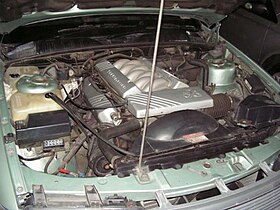Holden V8 engine
| Holden V8 engine | |
|---|---|
 | |
| Overview | |
| Manufacturer | Holden |
| Production | 1969–2000 |
| Layout | |
| Displacement | 253 cu in (4,142 cc) (1969–1984) 304 cu in (4,987 cc) (1985–2000) 308 cu in (5,044 cc) (1969–1985) 344 cu in (5,643 cc) (1986–1988, HDT) 350 cu in (5,737 cc) (1994–1999, HSV) |
| Cylinder bore | 3.62 in (92 mm) 4.00 in (102 mm) |
| Piston stroke | 3.06 in (78 mm) |
| Valvetrain | OHV |
| Chronology | |
| Successor | General Motors small-block engine |
The Holden V8 engine is an overhead valve (OHV) V8 engine that was produced by the Australian General Motors subsidiary, Holden between 1969 and 2000. The engine was used initially in the Holden HT series; it was later utilised in the Torana and Commodore ranges. The final iteration, the HEC 5000i, was phased out in Holden passenger vehicles upon the release of the VT II Commodore in mid 1999, which featured the Gen III V8 imported from the United States. The engine continued in the VS III Commodore utility which continued to be sold alongside the VT model until the new generation VU Ute debuted in late 2000. VS III Statesman continued with the Holden V8 engine also for a short while until the new WH Statesman was released in 1999.
In addition to being Holden's mainstream performance engine throughout its production run, it was also a popular powerplant for kit cars and specials as well as for motorsport in Holden's efforts in the Australian Touring Car Championship and the Bathurst 1000 until 1995. Australian company Repco developed and built the Repco-Holden Formula 5000 engine for Formula 5000 and other racing applications using the block and head castings of the Holden V8 as its basis.[1] The engine featured many modifications including Lucas fuel injection and dual coil Bosch ignition and more than 150 special components designed by Repco.[2] The lifter bore angle in the engine block is 45 degrees from the block centerline.
Applications
Initially offered in 253 cu in (4,142 cc) and 308 cu in (5,044 cc) versions, the engines were intended to be offered as part of the 1968 Holden HK range, but the project ran behind schedule and instead became part of the 1969 HT model range. In the HT, the Holden V8 sold alongside the 350-cubic-inch (5.7 L) Chevrolet Small-Block engine until 1974 with the introduction of the HJ series.[3]

The V8 engine also appeared from 1971 in the Statesman range of large size luxury cars which Holden established as a separate marque, replacing the Holden badged Brougham. In 1974, both the 253 and 308 engines were added to the Torana range for the first time in the LH series (after an aborted attempt by Holden Dealer Team boss Harry Firth to introduce the V8 to the smaller LJ Torana range in 1972 which was stopped by the Supercar scare). The engines were also offered on the LX model range introduced in 1976, but not the final UC range which appeared in 1978.
Both engine capacities were offered on the first VB Commodores which appeared in 1978. The 253 version was not available in the VK Commodore range, released in 1984, but continued in Holden WB commercials until their cessation in late 1984. In 1985, the special editions modified by Holden and their official after-market tuner, Peter Brock's HDT Special Vehicles, began introducing the 4,987 cc (304 cu in) version of the engine, created to slip underneath the 5,000 cc engine capacity cut-off in Group A touring car regulations, allowing Commodore competitors to run at a lower competition weight. This slight shrinking of the traditional Holden 308 saw the Group A Commodore's racing weight drop from 1,400 to 1,325 kilograms (3,086 to 2,921 lb). Due to the complex Group A regulations, this also allowed the racing cars to run bigger wheels and tyres without any drop in power. Indeed, the VK Commodore SS Group A was one of the fastest cars in the world of Group A racing when it hit the tracks in 1986.
HDT Special Vehicles also offered a more powerful version of the engine enlarged to 5,643 cubic centimetres (344 cu in) in some of its VL models between 1986 and 1988, including the controversial Calais Director. This engine, making as much as 231 kW (310 hp), was an expensive option, particularly once Holden severed ties with HDT in February 1987, which drastically increased the prices of all HDT models, and consequently very few of the 5.6-litre motors were made.
Fuel injection replaced the carburettors initially on the VL Commodore SS Group A SV, again with Group A touring car racing in mind, this car produced by Holden's new performance vehicle partner Holden Special Vehicles (HSV) in partnership with British-based Tom Walkinshaw Racing (TWR). While Group A disappeared after the VN model range, the fuel injected 4,987-cubic-centimetre (304 cu in) engine was offered in Commodores until the VS III Commodore utility in 2000, although there were no longer V8 VS III utilities available for sale during the latter part of 2000.
HSV vehicles featured a variety of more powerful versions of the 5.0-litre, which were also available on regular V8 Holdens as part of the SV Enhanced package. Additionally, from 1994 with the VR series, a 5,737-cubic-centimetre (350 cu in) "stroker" was standard on the HSV GTS and optional on the HSV Senator, and later on the Statesman/Caprice-based Grange from that model's introduction in 1996.
See also
References
- ^ Repco advertisement, "Guide to the Gold Star, Supplement to Racing Car News, August 1972, page xvi
- ^ Sergent, Bruce. "1970 Tasman Series". sergent.com.au. Archived from the original on 7 October 2009.
- ^ Holden Ltd – The Holden Heritage, 8th Edition (1998)
